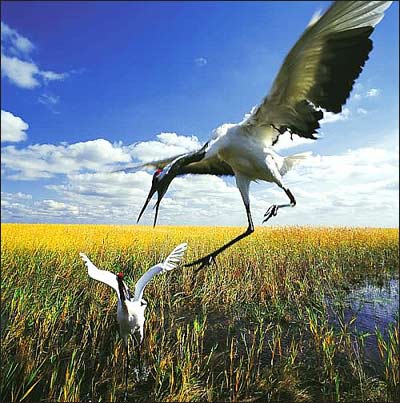China has rich biodiversity, boasting the world's largest number of bird species and gymnosperm varieties. But China's biodiversity is faced with a critical situation: 15 to 20 percent of higher plant varieties are endangered, threatening the existence of 40,000 species of organisms related with them.
As one of the earliest contracting country to the Convention on Biological Diversity, China has been active in international affairs concerning the Convention and vocal on important issues related to biodiversity. China is also one of the few countries to complete the Convention's action plans. The China Action Plan for Biodiversity Conservation implemented in 1994 provided rules and regulations for many eco-environmental protection activities. According to the Law on the Protection of Wildlife, the highest punishment for crimes of damaging wildlife resources is the death penalty.
Emphasizing effective protection of biological resources, government departments have built and put into operation facilities for preserving genetic resources. In January 2003, the Chinese Academy of Sciences initiated a project to save endangered plants with the aim of increasing the plant varieties from 13,000 to 21,000 under the protection of its 12 affiliated botanic gardens within 15 years, and to build a botanic garden covering a total area of 458 sq km, which will be the world's largest. The project involves over 300 million yuan investment into the collection of rare and endangered plants, and gene banks will be built with the Qinling Mountain, Wuhan, Xishuangbanna and Beijing as the centers.
To help save endangered wildlife, 250 wildlife breeding centers have been established throughout the country, and special projects conducted to protect seven species, including giant pandas and red ibises. Giant panda numbers have risen from 1,100 to over 1,590 and their conditions continue to improve. The red ibis population has increased from seven to over 750, relieving that bird's endangered situation. The population of artificially bred Chinese alligators is nearly 10,000. The population of Eld's deer has increased from 26 to 1,600. The population of relic gulls has increased from 2,000 to more than 10,000. Sightings of tigers, rare in recent times, have been reported in the northeastern, eastern and southern parts of China. The number of artificially bred South-China tiger grew to 68 while the number of Northeast tiger has exceeded 1,300. In freshwater dolphin studies, China's research on white-flag dolphins leads the world and its research on artificial breeding of white-flag dolphins has accelerated. Thanks to persistent combat against poaching and the cooperation of many international animal protection organizations, the Tibetan antelope population, which had shrunken sharply because of poaching, has reached about 190,000.

